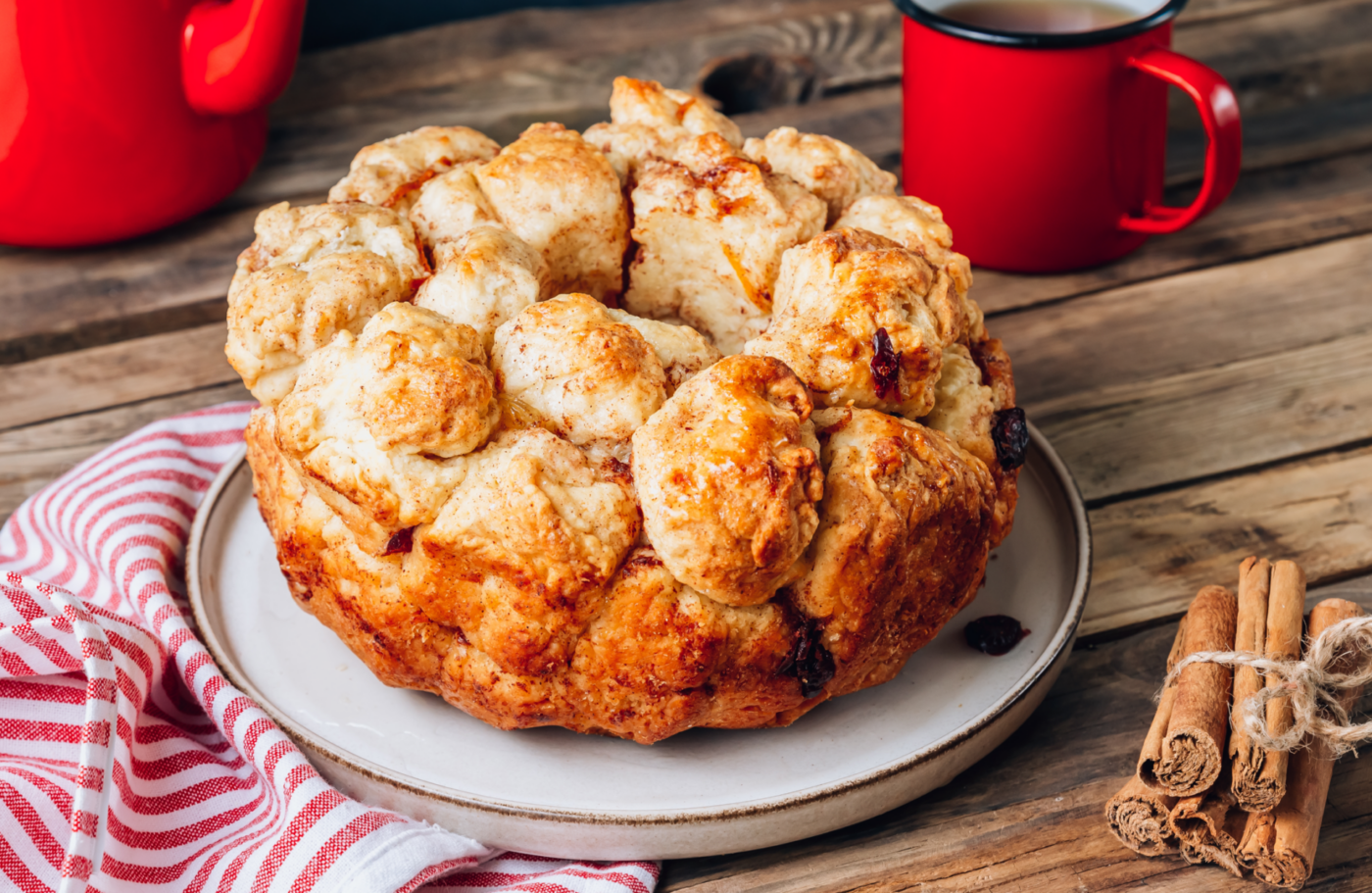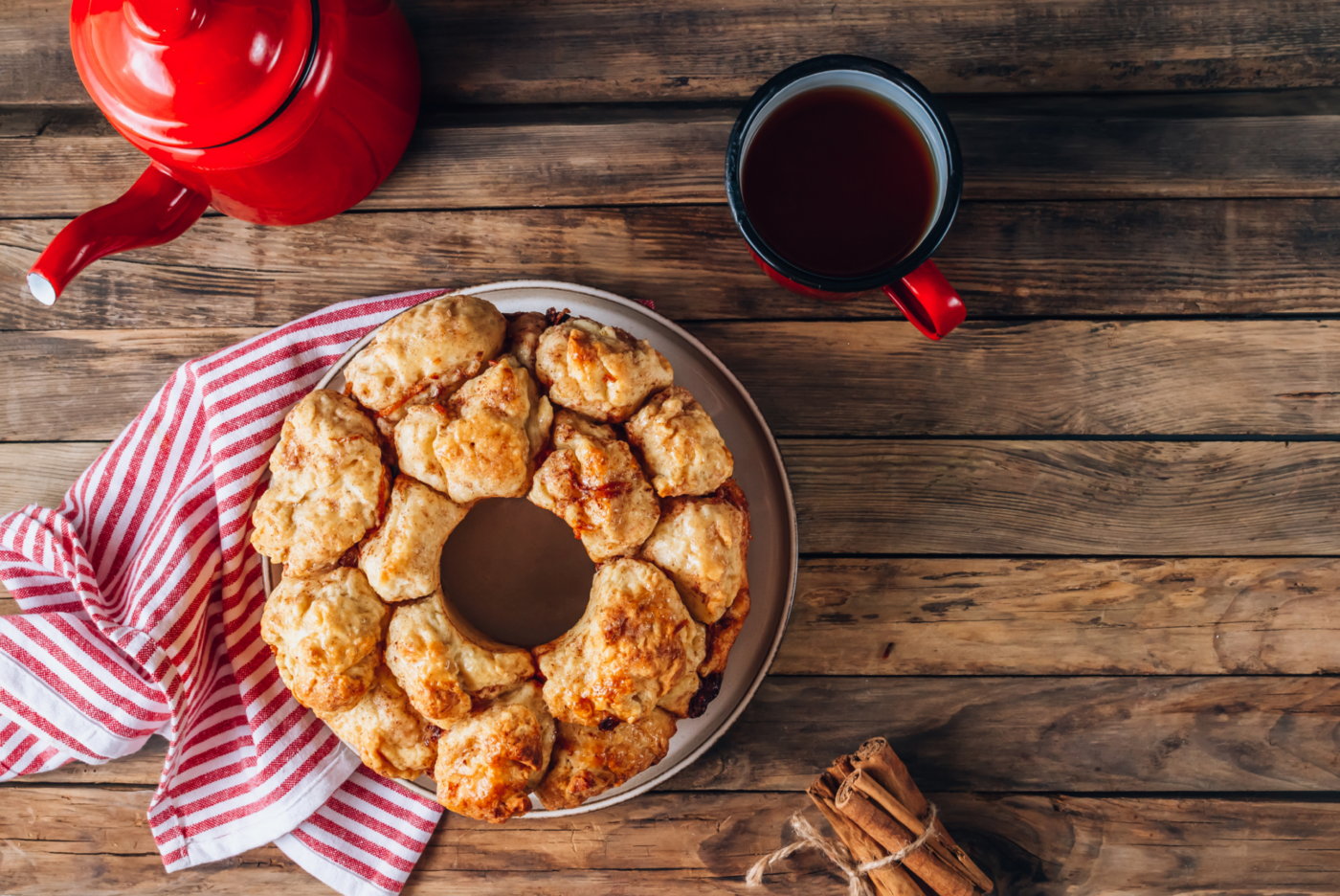Read More: History of Monkey Bread
The Hungarian Connection: Exploring the Aranygaluska Ancestry
Many food historians believe that monkey bread’s origins can be traced back to a traditional Hungarian dessert known as Aranygaluska. This name translates to “golden dumpling” or, more literally, “golden pull-apart cake.” This traditional dish features balls of yeast dough that are individually dipped in melted butter, then rolled in a mixture of sugar and ground nuts (typically walnuts). These coated dough balls are then carefully layered in a tube pan or Bundt pan, often with raisins or other dried fruits interspersed between the layers.
Aranygaluska is baked until golden brown and served warm. The individual dumplings are easily pulled apart, making it a naturally shareable dessert. The similarities to American monkey bread are undeniable: the yeasty dough balls, the generous buttery coating, the sweet, often nutty filling, and the pull-apart nature of the finished product.
It is theorized that Hungarian immigrants brought Aranygaluska with them to the United States in the late 19th and early 20th centuries, during a period of significant immigration from Eastern Europe. As the recipe adapted to American ingredients and tastes, it may have gradually evolved into what we now know as monkey bread. The transition likely involved a simplification of the process, perhaps substituting readily available ingredients for those less common in American kitchens.
The Rise of Monkey Bread in Mid-Century America: Convenience and the Bundt Pan
While the connection to Aranygaluska provides a compelling origin story, the term “monkey bread” and the specific recipes we associate with it today appear to be a distinctly American phenomenon. The first known printed recipes for monkey bread began to emerge in the United States in the late 1940s and 1950s. These early recipes often appeared in women’s magazines, community cookbooks, and publications aimed at homemakers, reflecting the post-war emphasis on convenience and family-friendly meals.
One key difference between Aranygaluska and early monkey bread recipes was the use of pre-made refrigerated biscuit dough. This shortcut, likely born out of the increasing availability of convenience foods in the mid-20th century, made monkey bread much more accessible and convenient for the average American home cook. It eliminated the need for making yeast dough from scratch, significantly reducing preparation time.
The use of a Bundt pan also became a defining characteristic of American monkey bread. The Bundt pan, with its distinctive ring shape and central tube, was popularized in the 1950s and 1960s by the Nordic Ware company. Its unique design not only created an attractive presentation but also helped ensure even cooking of the dense, layered dough. The central tube allowed heat to penetrate the center of the bread, preventing it from being undercooked while the outer layers became too brown.
The Mystery of the Name: Monkeys, Actresses, and Pull-Apart Fun
The origin of the name “monkey bread” itself is a bit of a mystery, adding another layer of intrigue to the pastry’s history. One popular, though unsubstantiated, theory attributes it to the actress ZaSu Pitts, a well-known Hollywood personality during the mid-20th century, known for her comedic roles and distinctive voice. However, there is no definitive proof to support this claim, and the connection remains largely anecdotal.
A more plausible explanation is that the name refers to the way the bread is eaten. The baked dough balls are easily pulled apart and picked at, a manner of eating that someone might playfully associate with how a monkey might eat its food. This theory is supported by the fact that other names used for monkey bread, such as “bubble bread,” “pinch-me cake,” or “pull-apart bread,” are more directly descriptive of its appearance and texture.
Nancy Reagan and the Monkey Bread Craze: A First Lady’s Influence
Monkey bread’s popularity received a significant boost in the 1980s thanks to an unexpected source: First Lady Nancy Reagan. Mrs. Reagan was known for serving monkey bread at the White House during the Christmas season. This high-profile endorsement brought monkey bread to the attention of a wider audience. Media coverage of the First Lady’s holiday menus, combined with the growing popularity of convenience foods and easy-to-prepare recipes, helped solidify monkey bread’s status as a beloved American treat, particularly during the holiday season.
Variations and Innovations: From Sweet to Savory and Beyond
Over the years, it has inspired countless variations and innovations. While the classic cinnamon-sugar version, often drizzled with a simple glaze, remains a popular choice, bakers and home cooks have experimented with a wide range of flavors and fillings, pushing the boundaries of what monkey bread can be.
- Savory Monkey Bread: Savory versions of monkey bread have gained popularity, demonstrating the versatility of the basic concept. These savory iterations often feature ingredients like garlic, herbs (such as rosemary, thyme, or parsley), various types of cheese (cheddar, Parmesan, mozzarella), and even meats like cooked bacon or sausage. These savory variations are often served as appetizers, side dishes, or even a fun alternative to traditional dinner rolls.
- Fruit-Filled Monkey Bread: Adding fruit to monkey bread provides another dimension of flavor and texture. Popular choices include diced apples, blueberries, raspberries, sliced peaches, or even cranberries during the holiday season. These additions often complement the sweetness of the dough and create a more complex flavor profile.
- Chocolate Monkey Bread: For chocolate lovers, there are numerous variations of monkey bread that incorporate cocoa powder into the dough, use chocolate chips as a filling, or feature a rich chocolate glaze. Some recipes even incorporate chocolate hazelnut spread for an extra decadent treat.
- Pizza Monkey Bread: A fun and flavorful twist, pizza monkey bread combines the pull-apart concept with the flavors of pizza. The dough balls are typically coated in garlic butter, filled with mozzarella cheese and pepperoni or other pizza toppings, and then baked until golden brown and bubbly. A side of marinara sauce for dipping completes the experience.
- Other Creative Variations: Caramel apple, pumpkin spice, lemon poppy seed, and even versions inspired by popular desserts like sticky buns or cinnamon rolls demonstrate the boundless creativity that monkey bread inspires.
A Modern Classic: Enduring Appeal in a Changing Culinary Landscape
Today, it remains a beloved treat enjoyed across the United States and beyond. Its easy preparation, customizable nature, and inherent shareability make it a popular choice for potlucks, parties, family gatherings, and casual brunches. Whether made from scratch with homemade yeast dough or with the help of convenient shortcuts like refrigerated biscuits or even frozen bread dough, monkey bread continues to delight with its gooey texture, sweet (or savory) flavor, and nostalgic appeal.
Conclusion: A Sweet and Sticky Slice of Culinary History
The history of monkey bread is a testament to the way food can evolve and adapt across cultures and generations. From its possible roots in a traditional Hungarian dessert to its rise as a mid-century American favorite and its continued popularity today, monkey bread’s journey is a delicious reminder of the power of food to connect us to the past and to bring people together. The story of monkey bread is interwoven with tales of immigration, culinary innovation, the rise of convenience foods, and even a touch of celebrity influence. So, the next time you enjoy a warm, sticky piece of monkey bread, take a moment to appreciate the rich and fascinating history behind this beloved pull-apart treat. It’s a sweet and sticky slice of culinary history that continues to be written with every batch baked and every piece shared.



Share
Click on the icons below to share "Title of the item to share"